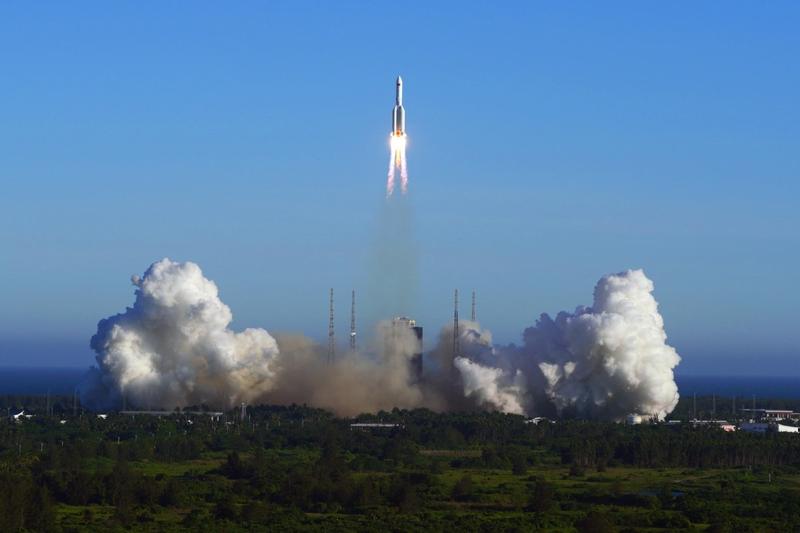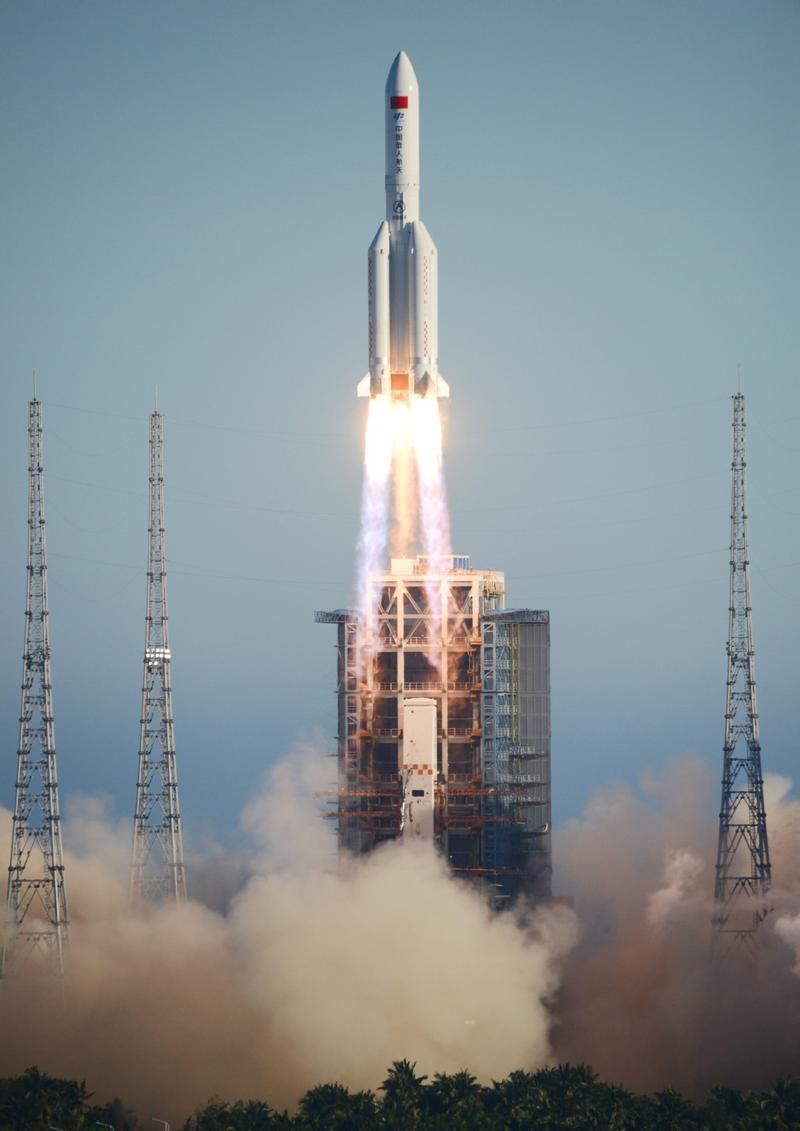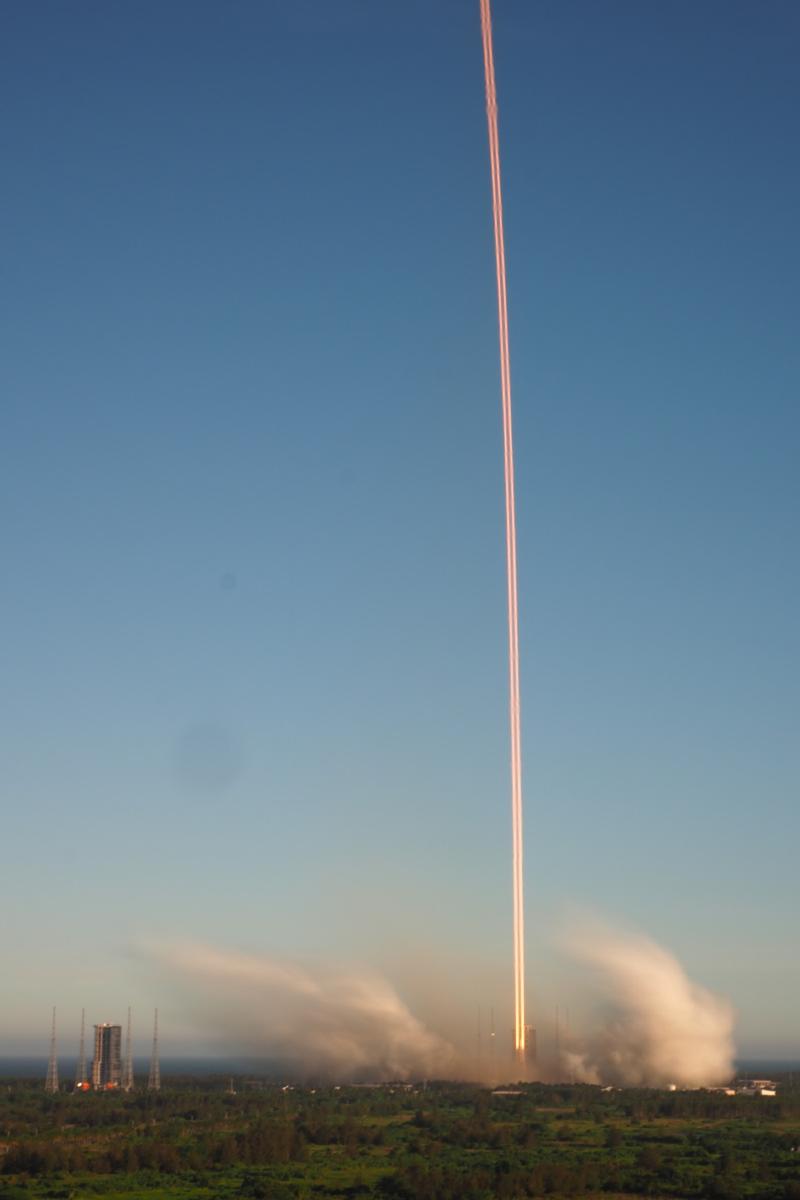 China's Long March 5B carrier rocket makes its debut flight from the Wenchang Space Launch Center in Hainan province on May 5, 2020. (SU DONG / CHINADAILY.COM.CN)
China's Long March 5B carrier rocket makes its debut flight from the Wenchang Space Launch Center in Hainan province on May 5, 2020. (SU DONG / CHINADAILY.COM.CN)
WENCHANG, Hainan - China's new large carrier rocket Long March-5B made its maiden flight on Tuesday, sending the trial version of China's new-generation manned spaceship and a cargo return capsule for test into space.
Specially developed for China's manned space program, Long March-5B will be mainly used to launch the modules of the space station
The successful flight inaugurated the "third step" of China's manned space program, which is to construct a space station, said the China Manned Space Agency (CMSA).
The white large rocket blasted off from the Wenchang Space Launch Center on the coast of southern China's island province of Hainan at 6 p.m. (Beijing Time).
About 488 seconds later, the experimental manned spacecraft with no crew, together with the test version of the cargo return capsule, separated with the rocket and entered the planned orbit, according to CMSA.
ALSO READ: Final checks for rocket complex at Wuhan base
Specially developed for China's manned space program, Long March-5B will be mainly used to launch the modules of the space station.
The Long March-5B carrier rocket will help expand China's aerospace activities, said Wang Xiaojun, head of the China Academy of Launch Vehicle Technology under the China Aerospace Science and Technology Corporation (CASC).
Modified on the basis of Long March-5, the new large rocket has a total length of about 53.7 meters, which is as tall as an 18-floor building, and has a 5-meter-diameter core stage and four 3.35-meter-diameter boosters, as well as a 20.5-meter-long and 5.2-meter-diameter fairing.
The rocket uses environment-friendly propellants, including liquid oxygen, liquid hydrogen and kerosene. It has a takeoff mass of about 849 tonnes and is able to send over 22 tonnes of payloads, equivalent to the weight of more than 10 cars, to low-Earth orbit, which is currently the largest low-Earth orbit carrying capacity among China's rockets.
 China's Long March 5B carrier rocket makes its debut flight from the Wenchang Space Launch Center in Hainan province on May 5, 2020. (SU DONG / CHINADAILY.COM.CN)
China's Long March 5B carrier rocket makes its debut flight from the Wenchang Space Launch Center in Hainan province on May 5, 2020. (SU DONG / CHINADAILY.COM.CN)
The successful maiden flight verified the design of the rocket. A series of technological breakthroughs have been achieved such as the separation of the large fairing and the payloads in space and the precise control of the rocket to enter orbit directly with high thrust, laying the foundation for constructing China's space station, CMSA said.
The new manned spacecraft is designed to adapt to multiple tasks including low-Earth orbit missions and deep-space explorations. The spacecraft comprises a service capsule and a return capsule.
The mission will test the key technologies of the new spaceship such as the control of its re-entry into the atmosphere, heat shielding and recovery technology, according to the China Academy of Space Technology under CASC.
Some space science experiments, including space 3D printing, will be conducted on the experimental spacecraft.
The test version of a cargo return capsule, which is flexible and inflatable and developed by the Second Academy of the China Aerospace Science and Industry Corporation, was also sent into space on Tuesday.
Before the launch, joint drills of the Long March-5B rocket and the prototype core capsule of the space station had been conducted at the Wenchang Space Launch Center.
All personnel participating in the mission had overcome tremendous difficulties caused by the novel coronavirus epidemic, and the challenges and pressure brought by the recent failures of the Long March-7A and Long March-3B rockets.
 China's Long March 5B carrier rocket makes its debut flight from the Wenchang Space Launch Center in Hainan province on May 5, 2020. (SU DONG / CHINADAILY.COM.CN)
China's Long March 5B carrier rocket makes its debut flight from the Wenchang Space Launch Center in Hainan province on May 5, 2020. (SU DONG / CHINADAILY.COM.CN)
In 1992, China started its manned space program with a three-step strategy.
Yang Liwei carried out the first step -- to send an astronaut into space and return safely -- in the Shenzhou-5 mission in 2003.
The second step was developing advanced space flight techniques and technologies including extra-vehicular activity and orbital docking. This phase included the launch of Tiangong-1, a transitional platform to test the docking technology and the Tiangong-2 space lab.
READ MORE: New version of Long March to make its debut
So far, a total of 16 major missions of China's manned space program have been accomplished, with a success rate of 100 percent.
China has launched 11 manned spacecraft, one cargo spacecraft, Tiangong-1 and Tiangong-2, sending 11 astronauts into space, completing the first two steps of the manned space program.
The next step is to assemble and operate a permanent manned space station.
Tuesday's launch was the 331st mission of the Long March rocket series.


